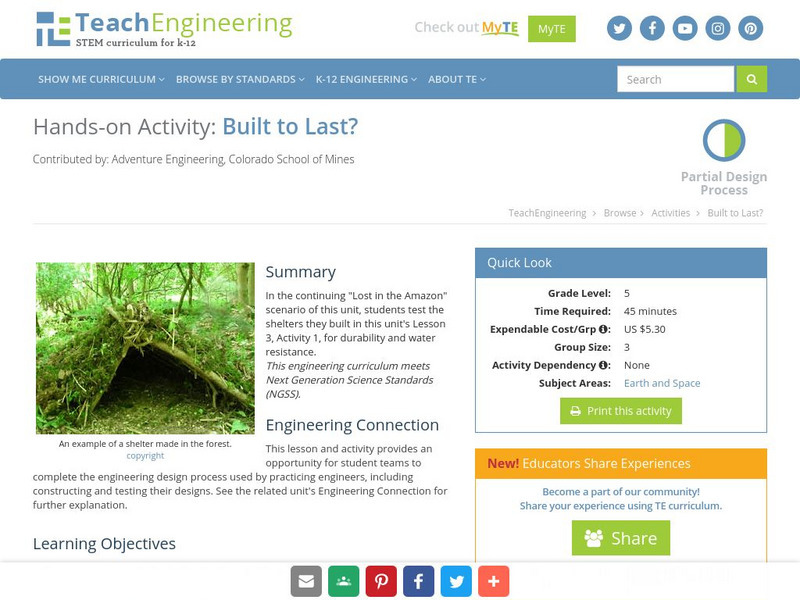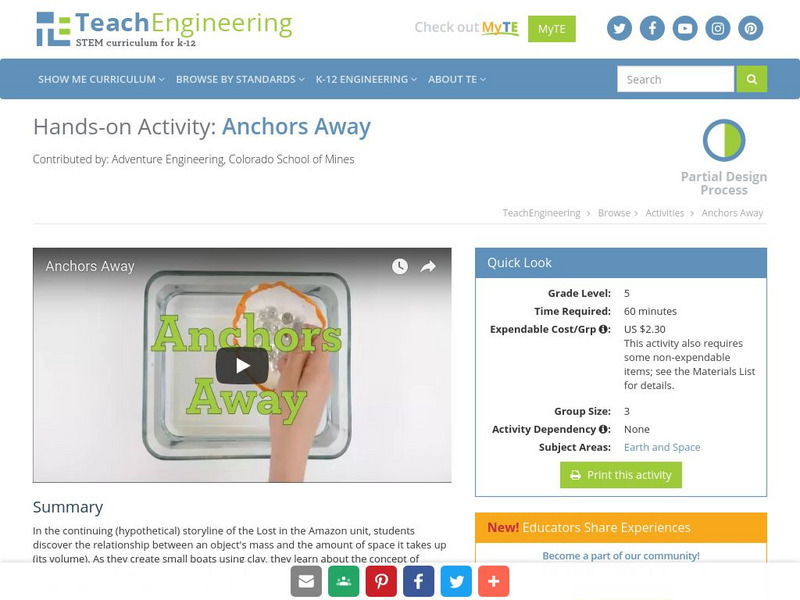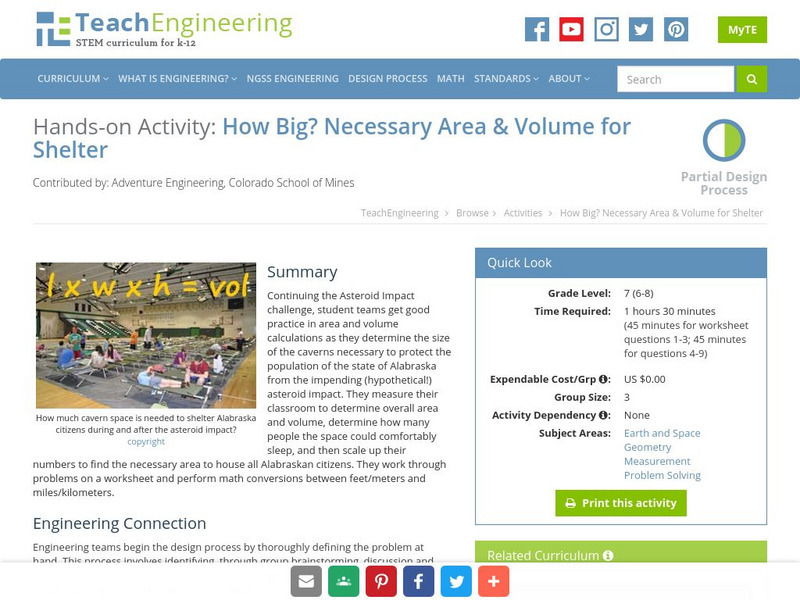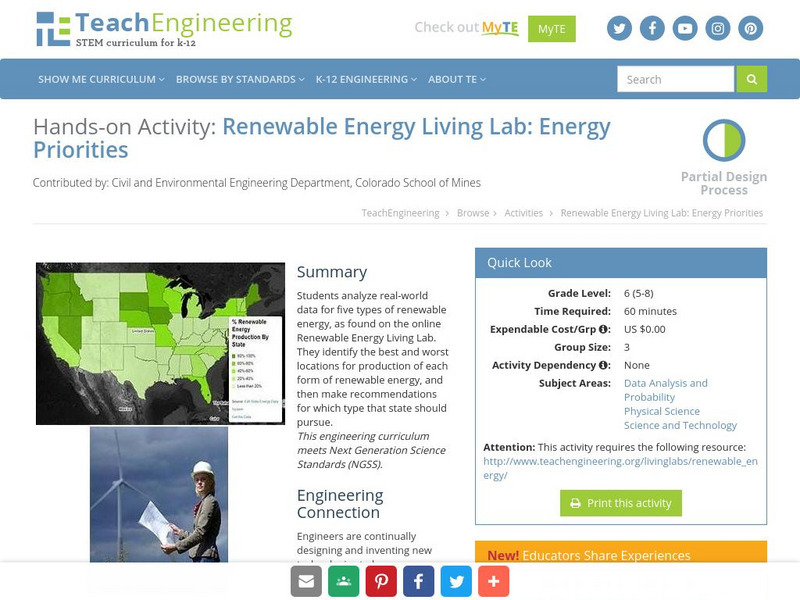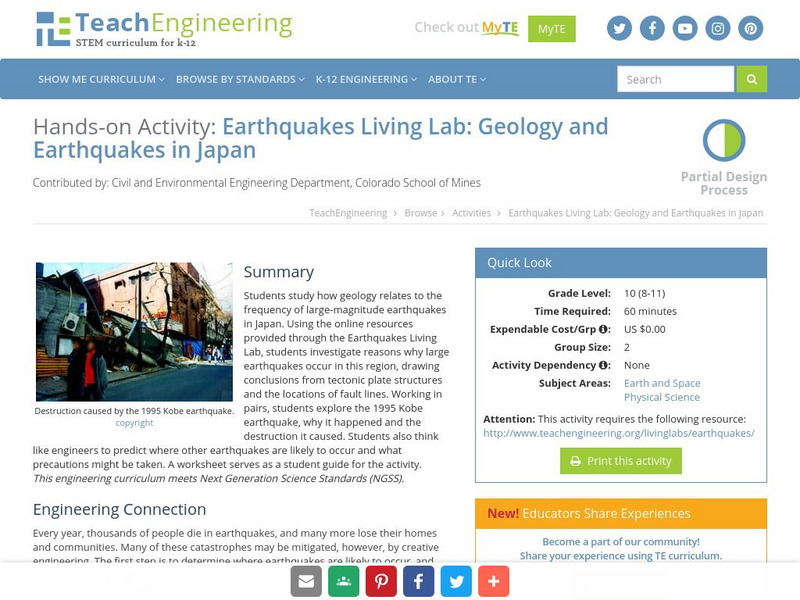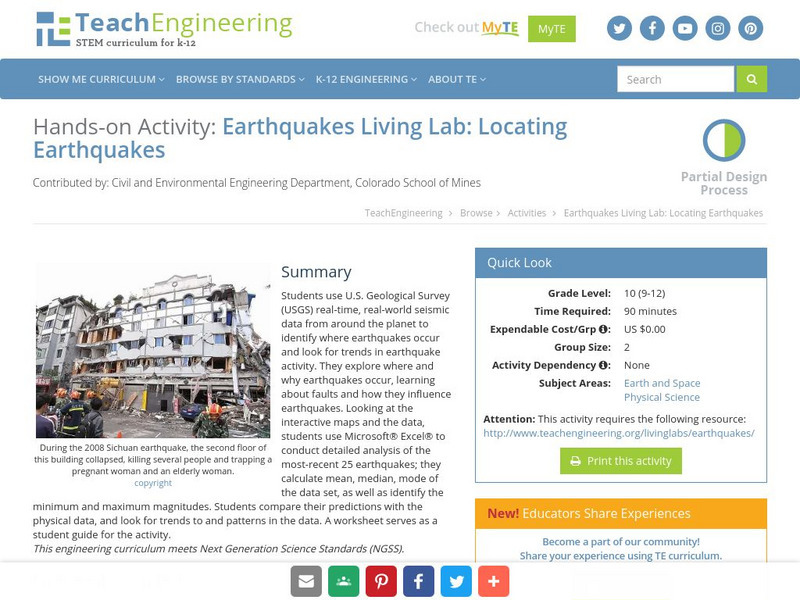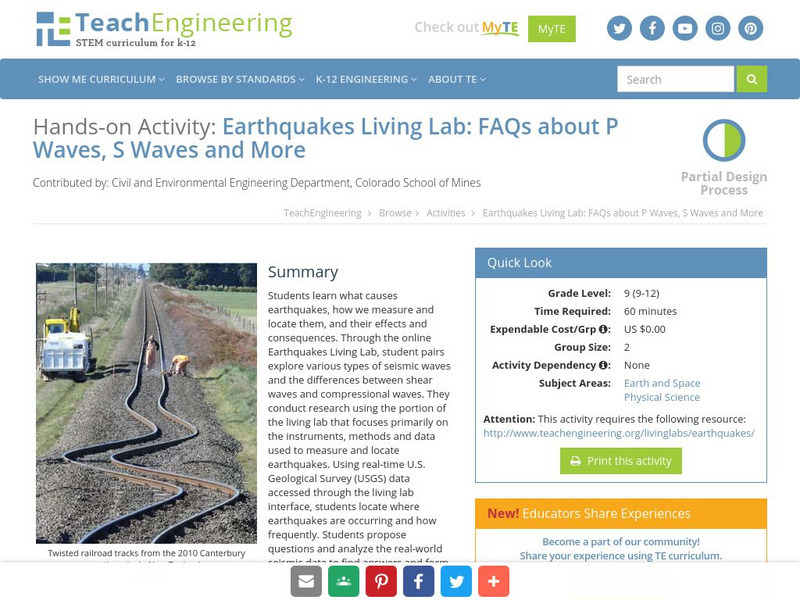TeachEngineering
Teach Engineering: Home, Sweet Home!
In this activity, the students will use wax paper shaped as leaves and kite string to build a shelter to protect them from the rain. The students will then test the shelters for durability and water resistance.
TeachEngineering
Teach Engineering: Built to Last?
In this activity, the students test the shelters they built in Lesson 3, Activity 1 for durability and water resistance.
TeachEngineering
Teach Engineering: Finding Food in the Amazon
In this activity, the students will investigate a variety of plants and animals common to the Amazon through research. They will determine the plant or animal characteristics that make them edible or useful for the trip and learn to...
TeachEngineering
Teach Engineering: Anchors Away
In this activity, the students will discover the relationship between an object's mass and the amount of space it takes up (its volume). The students will learn about the concept of displacement and how an object can float if it...
TeachEngineering
Teach Engineering: Taking the Boat to Manaus
In this activity, the students will apply the concepts they learned regarding mass, volume and density in the previous activities to design a boat.
TeachEngineering
Teach Engineering: Eye Witness Reporting
In this activity, the students will develop a briefing for a T.V. evening news program that summarizes their experiences surviving in the Amazon rainforest. The students will have the opportunity to role play as interviewer and...
TeachEngineering
Teach Engineering: What's the Problem?
Students learn of the impending asteroid impact scenario, form teams and begin to study the situation in depth. A simple in-class simulation shows them the potential for destruction and disaster. They complete worksheets and look at maps...
TeachEngineering
Teach Engineering: How Big?
Students teams determine the size of the caverns necessary to house the population of the state of Alabraska from the impending asteroid impact. They measure their classroom to determine area and volume, determine how many people the...
TeachEngineering
Teach Engineering: Scaling the Map
Students learn how to determine map distances and areas using the map scale. They get a feel for how much an area represents on the map in relation to the size they are suggesting for their underground caverns to shelter the Alabraska...
TeachEngineering
Teach Engineering: Possible Locations
Students use their knowledge of scales and areas to determine the best locations in Alabraska for the underground caverns. They cut out rectangular paper pieces to represent caverns to scale with the maps and place the cut-outs on the...
TeachEngineering
Teach Engineering: Rocks, Rocks, Rocks
Students test rocks to identify their physical properties (such as luster, hardness, color, etc.) and classify them as igneous, metamorphic or sedimentary. They complete a worksheet table to record all of the rock properties, and then...
TeachEngineering
Teach Engineering: Ranking the Rocks
Student teams assign importance factors, called "desirability points," the rock properties found in the previous lesson/activity in order to mathematically determine the overall best rocks for building caverns within. They learn the...
TeachEngineering
Teach Engineering: Drum Roll Please
Student teams commit to a final decision on the location they recommend for safe underground cavern shelter for the citizens of Alabraska. They prepare and deliver final presentations to defend their final decisions to the class.
TeachEngineering
Teach Engineering: Testing the Caverns
Students build model caverns and bury them in a tray of sand. They test the models by dropping balls onto them to simulate an asteroid hitting the Earth. By molding papier-mache or clay around balloons (to form domes), or around small...
TeachEngineering
Teach Engineering: Renewable Energy Living Lab: The Bright Idea
Students use real-world data to evaluate the feasibility of solar energy and other renewable energy sources in different U.S. locations. Working in small groups, students act as engineers evaluating the suitability of installing solar...
TeachEngineering
Teach Engineering: Earthquakes Living Lab: Designing for Disaster
Students learn about factors that engineers take into consideration when designing buildings for earthquake-prone regions.
TeachEngineering
Teach Engineering: Renewable Energy Living Lab: Energy Experts
Students use real-world data to evaluate various renewable energy sources and the feasibility of implementing these sources. Working in small groups, students use data from the Renewable Energy Living Lab to describe and understand the...
TeachEngineering
Teach Engineering: Renewable Energy Living Lab: Energy Priorities
Students analyze real-world data for five types of renewable energy, as found on the online Renewable Energy Living Lab. They identify the best and worst locations for production of each form of renewable energy, and then make...
TeachEngineering
Teach Engineering: Earthquakes Living Lab: Epicenters and Magnitudes
Students learn how engineers characterize earthquakes through seismic data. Acting as engineers, they use real-world seismograph data to locate earthquake epicenters via triangulation and determine earthquake magnitudes.
TeachEngineering
Teach Engineering: Earthquakes Living Lab: Geology and Earthquakes in Japan
Using the online resources provided through the Earthquakes Living Lab, students investigate reasons why large earthquakes occur in Japan, drawing conclusions from tectonic plate structures and the locations of fault lines.
TeachEngineering
Teach Engineering: Earthquakes Living Lab: Locating Earthquakes
Students use U.S. Geological Survey real-time, real-world, seismic data from around the planet to identify where earthquakes occur and look for trends in earthquake activity.
TeachEngineering
Teach Engineering: Renewable Energy Living Lab: Power Your School
Students use real-world data to calculate the potential for solar and wind energy generation at their school location. After examining maps and analyzing data from the online Renewable Energy Living Lab, they write recommendations as to...
TeachEngineering
Teach Engineering: Renewable Energy Living Lab
Students become familiar with the online Renewable Energy Living Lab interface and access its real-world solar energy data to evaluate the potential for solar generation in various U.S. locations. They become familiar with where the most...
TeachEngineering
Teach Engineering: Earthquakes Living Lab: P Waves, S Waves and More
Students learn what causes earthquakes, how we measure and locate them, and their effects and consequences.



